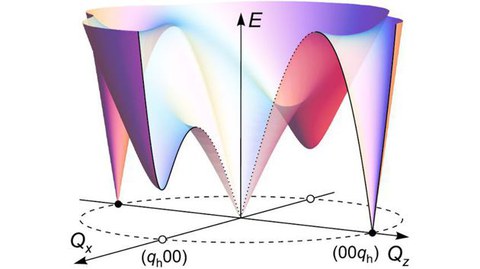Jan 04, 2018
Research: Pseudo-Goldstone Modes in a Helimagnet
The notion of symmetry is central for the description of crystalline solids and their physical properties. Phase transitions, such as water crystallizing into ice, lead to a change in symmetry. This general principle applies to phase transitions involving atoms, electrons, or their magnetic moments. According to the famous theorem named after the British theoretical physicist Jeffrey Goldstone, whenever a continuous symmetry is broken, a low-energy excitation with a zero energy gap (so-called Goldstone mode) will emerge. For a magnetic phase transition, this mode represents a spin-wave excitation (also known as magnon), stemming from the wave vector characterizing the magnetically ordered state. In most magnets, the low-energy spectrum consists exclusively of such Goldstone magnons, while everywhere else throughout the Brillouin zone, the magnon energies are much higher. It has been therefore assumed that only the Goldstone magnons in the vicinity of the magnetic ordering vectors would contribute to the low-temperature thermodynamic and transport properties of a material.
In the cubic spinel compound ZnCr2Se4, the Cr3+ magnetic moments order into a helical spiral that propagates along one of the principal cubic axes. This defines the magnetic ordering vector that is spontaneously chosen out of the three crystallographically equivalent directions in the lattice. Using inelastic neutron scattering, we have compared the magnon spectra around the ordering vector and near its crystallographically equivalent counterparts that are orthogonal to the spiral. While the Goldstone theorem guarantees the existence of low-energy magnon modes only at the ordering vector, we have found similar modes also at the two orthogonal wave vectors. They are characterized by a tiny energy gap and have been therefore termed pseudo-Goldstone magnons. This example is remarkable, as it demonstrates that the magnetic contribution to the low-temperature thermodynamic properties can be dominated by spin waves that reside far away from the ordering wave vector in momentum space. Our result should be applicable to a very broad class of materials in which the magnetic propagation vector is spontaneously chosen from multiple structurally equivalent alternatives upon crossing a transition to the magnetically ordered state.
Y. V. Tymoshenko, Y. A. Onykiienko, T. Müller, R. Thomale, S. Rachel, A. S. Cameron, P. Y. Portnichenko, D. V. Efremov, V. Tsurkan, D. L. Abernathy, J. Ollivier, A. Schneidewind, A. Piovano, V. Felea, A. Loidl, D. S. Inosov,
Pseudo-Goldstone Magnons in the Frustrated S=3/2 Heisenberg Helimagnet ZnCr2Se4 with a Pyrochlore Magnetic Sublattice,
Phys. Rev. X 7, 041049 (2017) (arXiv)

